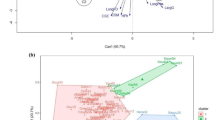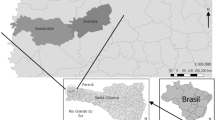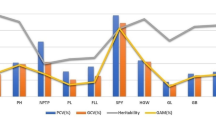Abstract
Weedy rice (Oryza sativa L.) is an important resource for breeding and for studying the evolution of rice. The present study was carried out to identify the genetic basis of the weedy rices distributed in various countries of the world. One hundred and fifty two strains of weedy rice collected from Bangladesh, Brazil, Bhutan, China, India, Japan, Korea, Nepal, Thailand and the USA were tested for variations in six morpho-physiological characteristics and in 14 isozyme loci. Twenty six weedy strains selected from the above materials were assayed for the Est-10 locus, six RAPD loci of the nuclear genome, and one chloroplast locus. From the results of multivariate analysis based on the morpho-physiological characteristics and the isozymes, weedy rice strains were classified into indica and japonica types, and each type was further divided into forms resembling cultivated and wild rice. Thus, four groups designated as I, II, III and IV were identified. Weedy strains of group I (indica-type similar to cultivars) were distributed mostly in temperate countries, group II (indica-type similar to wild rice) in tropical countries, group III (japonica-type similar to cultivars) in Bhutan and Korea, group IV ( japonica-type similar to wild rice) in China and Korea. In group I, classified as indica, several strains showed japonica-specific RAPD markers, while some others had japonica cytoplasm with indica-specific RAPD markers in a heterozygous state at several loci. One weedy strain belonging to group II showed a wild rice-specific allele at the Est-10 locus. However, in groups III and IV, no variation was ound either for the markers on Est-10 or for the RAPD loci tested. Judging from this study, weedy rice of group I might have originated at least partly from gene flow between indica and japonica, whereas that of group II most probably originated from gene flow between wild and cultivated indica rice. Weedy rice of group III is thought to have originated from old rice cultivars which had reverted to a weedy form, and that of group IV from gene flow between japonica cultivars and wild rice having japonica backgrounds.
Similar content being viewed by others
Author information
Authors and Affiliations
Additional information
Received: 2 May 1996 / Accepted: 30 August 1996
Rights and permissions
About this article
Cite this article
Suh, H., Sato, Y. & Morishima, H. Genetic characterization of weedy rice (Oryza sativa L.) based on morpho-physiology, isozymes and RAPD markers. Theor Appl Genet 94, 316–321 (1997). https://doi.org/10.1007/s001220050417
Issue Date:
DOI: https://doi.org/10.1007/s001220050417




